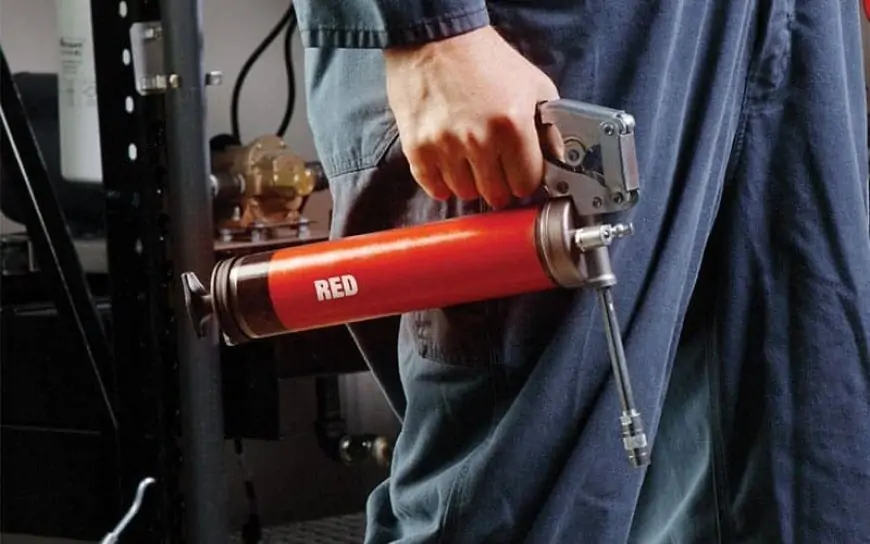Most maintenance work for your machines — be it a compact tractor, a riding lawnmower or an ATV — involves greasing. But for many, the world of grease guns and grease is intimidating. With all the different types of grease guns and grease, how do you know what’s right for you? In this article, we will cover everything you need to know about grease guns and grease to help you make an informed purchase.
The Fundamentals on Grease Guns
What are Grease Guns?Grease guns are devices that you hold in your hand and use to place lubricant (grease) into machines using small connector points called zerk fittings. You will find these fittings on many areas of the equipment, including joints, bearings and suspension components. Using the right grease gun suits your machine's needs for proper operation and long life.
Types of Grease Guns
There are a few different types of grease guns, with their own pros and cons. But most very common ones that I would discuss are:
Standard Grease Guns
Design: These are the classic grease guns that have been available for decades. They have a pull-back plunger and you simply unscrew the outer tube to swap out the grease cartridge.
- Pros: Available everywhere, inexpensive, works with most grease cartridges
- Cons: Can get messy to use, fierce to air bubbles, can leak grease
- Recommended Product: DEWALT Grease Gun – A reliable and durable option for general-purpose use.
Lube Shuttle Grease Guns
Design: A newer design, these guns use sealed cartridges that are simple to swap out. Just push up the bottom, insert a new cartridge, and you’re off to the races.
- Pros: They are cleaner, more user-friendly and less leak-prone.
- Cons: These are typically pricier, with fewer printer brands providing compatible cartridges.
- Recommended Product: Lincoln 1162 Air Operated Grease Gun – A high-quality option for those who prefer a cleaner, more efficient system.
Lever Handle Grease Guns
Design: These guns rely on a lever-based design to pump grease, which makes them less strenuous on your hands and great for heavy-duty applications.
- Pros: Excellent for high-pressure work and easier to use.
- Pros: Operates with both hands, and can be smooth in snug spaces.
- Recommended Product: Plews 55001 Lever Grease Gun – A sturdy and reliable choice for heavy-duty tasks.
Pistol Grip Grease Guns
- Design: Small enough to be used with one hand, these guns are ideal for light to moderate greasing.
- Pros: Simple design, very portable; suitable for small machinery.
- Recommended Product: Lumax LX-1632 Black Pistol Grip Grease Gun – A user-friendly option for light greasing tasks.
Share All sharing options for: Best Handheld Killers Pros: Low pressure output; makes hands tired during prolonged use.
Electric Grease Guns
- Design: These guns are battery-powered and usually designed for convenience and ease for users that do a lot of greasing.
- Pros: Easy to use, high-pressure, great for big machinery.
- Pros: Very expensive; over-greasing is possible with careful use.
- Recommended Product: DEWALT 20V MAX Cordless Grease Gun – A powerful and efficient tool for heavy-duty applications.
Pneumatic (Air) Grease Guns
- Design — Uses compressed air, which makes these types of guns the best choice for factory environments with air lines.
- Cons: Limited pressure and only one use.
- Pros: Pump by hand; no need for air compressor, can be more portable.
- Recommended Product: Lincoln 1162 Air Operated Grease Gun – A top choice for industrial and professional use.
Choosing the Right Grease
After choosing the right grease gun, the next is to select the right grease. Lubricant grease consists of oil, thickeners, and additives. You need the right grease to make sure your machinery does its job and does not wear out.
Types of Grease
Lithium-Based Grease
- Best For: General use, including automotive and household.
- Pros: Water resistant; responds well to large temperature variations.
Calcium-Based Grease
- Best For: Marine and other wet environments.
- Pros: Great water resistance.
Synthetic Grease
- Best For: Heavy-duty high-temperature and high-pressure applications.
- Pros: Durable, great in tough conditions.
Molybdenum Disulfide Grease
- Best For: Industrial applications, like construction vehicles.
- Pros: Lowers friction and wear in high-load areas.
Best Practice for Effective Grease Guns
- Pick the Right Hose Length: A flexible hose (approximately 22 inches) helps reach zerk fittings in tight locations.
- Some grease guns use a locking coupler that provides a solid connection onto the zerk fitting that helps prevent mess and conserve grease.
- LEAVE THE CLOSING OF THE GATES TO THE OWNER: The gates do not require any additional grease either as it may affect the seals and/or attract dirt.
- Regular Maintenance: Cleaning your grease gun after use and storing it properly will help prolong its lifespan.
Conclusion
Choosing the proper grease gun and grease shouldn’t be daunting. Knowing the types of grease guns and grease options and where they can be applied to keep your machinery running smoothly. If you’re a DIY enthusiast or a professional, having the right tools are worth the investment in terms of time, money and effort.
Please comment if you have any questions or need additional help. Happy greasing!















![[18+] Adult Telegram Groups Links for India [18+] Adult Telegram Groups Links for India](https://sociallyshout.com/uploads/images/202311/image_140x98_655b7e954cd20.webp)


